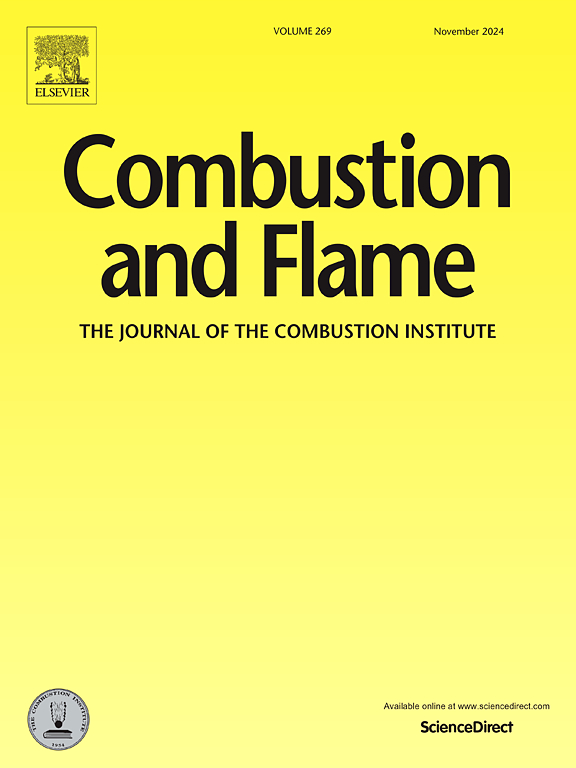A comparative study on the effects of NO2 addition on the auto-ignition behavior of n-heptane, iso-octane and toluene at engine relevant conditions
IF 5.8
2区 工程技术
Q2 ENERGY & FUELS
引用次数: 0
Abstract
It is necessary for gasoline surrogate models to simulate the effect of NOx addition on fuel auto-ignition behavior, as NOx can affect engine combustion via exhaust gas recirculation (EGR). Toluene is often used as a representative aromatic component in gasoline surrogate models, and hence it is important to investigate the effect of NOx addition on its auto-ignition behavior and to fully understand the interaction chemistry between toluene and NOx. In this paper, high-pressure shock tubes and a rapid compression machine are used to measure the ignition delay times (IDTs) of toluene in ‘air’ mixtures with and without the addition of nitrogen dioxide (NO2), at a pressure of 20 atm and at temperatures in the range 600–1400 K. The IDTs of n-heptane, iso-octane and a mixture of toluene/n-heptane/iso-octane are measured at the same conditions for comparison. The experimental results show that the auto-ignition behavior of toluene exhibits significantly different sensitivity to NO2 addition compared to n-heptane and iso-octane. NO2 significantly promotes the reactivity of toluene at low temperatures (600–1000 K), in which the IDTs decreased by two orders of magnitude when 1000 ppm of NO2 is added, whereas there is an order of magnitude decrease with the addition of 200 ppm NO2. The promoting effect of NO2 on toluene oxidation reduces significantly at temperatures above 1000 K. The experimental results also show that NO2 addition exhibits a slight promoting effect on the reactivity of n-heptane and iso-octane at temperatures above 750 K at the conditions studied. A kinetic model is proposed based on C3MechV3.3 in which the interaction chemistry between these gasoline surrogates and NOx is updated. The proposed kinetic model can simulate well the effect of NO2 addition on the auto-ignition behavior of these surrogates. Flux and sensitivity analyses are performed to highlight the important interaction reaction pathways.
在发动机相关工况下,对比研究了NO2添加量对正庚烷、异辛烷和甲苯自燃行为的影响
由于NOx会通过废气再循环(EGR)影响发动机燃烧,因此有必要建立汽油替代模型来模拟NOx添加对燃料自燃行为的影响。在汽油替代模型中,甲苯经常被用作代表芳香族成分,因此研究NOx添加对其自燃行为的影响以及充分了解甲苯与NOx之间的相互作用化学具有重要意义。在本文中,高压激波管和快速压缩机被用来测量“空气”混合物中甲苯的点火延迟时间(IDTs),添加和不添加二氧化氮(NO2),压力为20 atm,温度范围为600-1400 K。在相同的条件下,测定了正庚烷、异辛烷和甲苯/正庚烷/异辛烷的混合物的idt,以进行比较。实验结果表明,与正庚烷和异辛烷相比,甲苯的自燃行为对NO2添加的敏感性有显著差异。在低温(600 ~ 1000 K)条件下,NO2对甲苯的反应活性有显著的促进作用,当NO2添加量为1000 ppm时,其idt降低了两个数量级,而当NO2添加量为200 ppm时,其idt降低了一个数量级。当温度高于1000 K时,NO2对甲苯氧化的促进作用明显减弱。实验结果还表明,在750 K以上的温度下,NO2的加入对正庚烷和异辛烷的反应活性有轻微的促进作用。提出了基于C3MechV3.3的动力学模型,更新了这些汽油代物与NOx的相互作用化学性质。所建立的动力学模型可以很好地模拟NO2添加对这些代物自燃行为的影响。通量和灵敏度分析强调了重要的相互作用反应途径。
本文章由计算机程序翻译,如有差异,请以英文原文为准。
求助全文
约1分钟内获得全文
求助全文
来源期刊

Combustion and Flame
工程技术-工程:化工
CiteScore
9.50
自引率
20.50%
发文量
631
审稿时长
3.8 months
期刊介绍:
The mission of the journal is to publish high quality work from experimental, theoretical, and computational investigations on the fundamentals of combustion phenomena and closely allied matters. While submissions in all pertinent areas are welcomed, past and recent focus of the journal has been on:
Development and validation of reaction kinetics, reduction of reaction mechanisms and modeling of combustion systems, including:
Conventional, alternative and surrogate fuels;
Pollutants;
Particulate and aerosol formation and abatement;
Heterogeneous processes.
Experimental, theoretical, and computational studies of laminar and turbulent combustion phenomena, including:
Premixed and non-premixed flames;
Ignition and extinction phenomena;
Flame propagation;
Flame structure;
Instabilities and swirl;
Flame spread;
Multi-phase reactants.
Advances in diagnostic and computational methods in combustion, including:
Measurement and simulation of scalar and vector properties;
Novel techniques;
State-of-the art applications.
Fundamental investigations of combustion technologies and systems, including:
Internal combustion engines;
Gas turbines;
Small- and large-scale stationary combustion and power generation;
Catalytic combustion;
Combustion synthesis;
Combustion under extreme conditions;
New concepts.
 求助内容:
求助内容: 应助结果提醒方式:
应助结果提醒方式:


